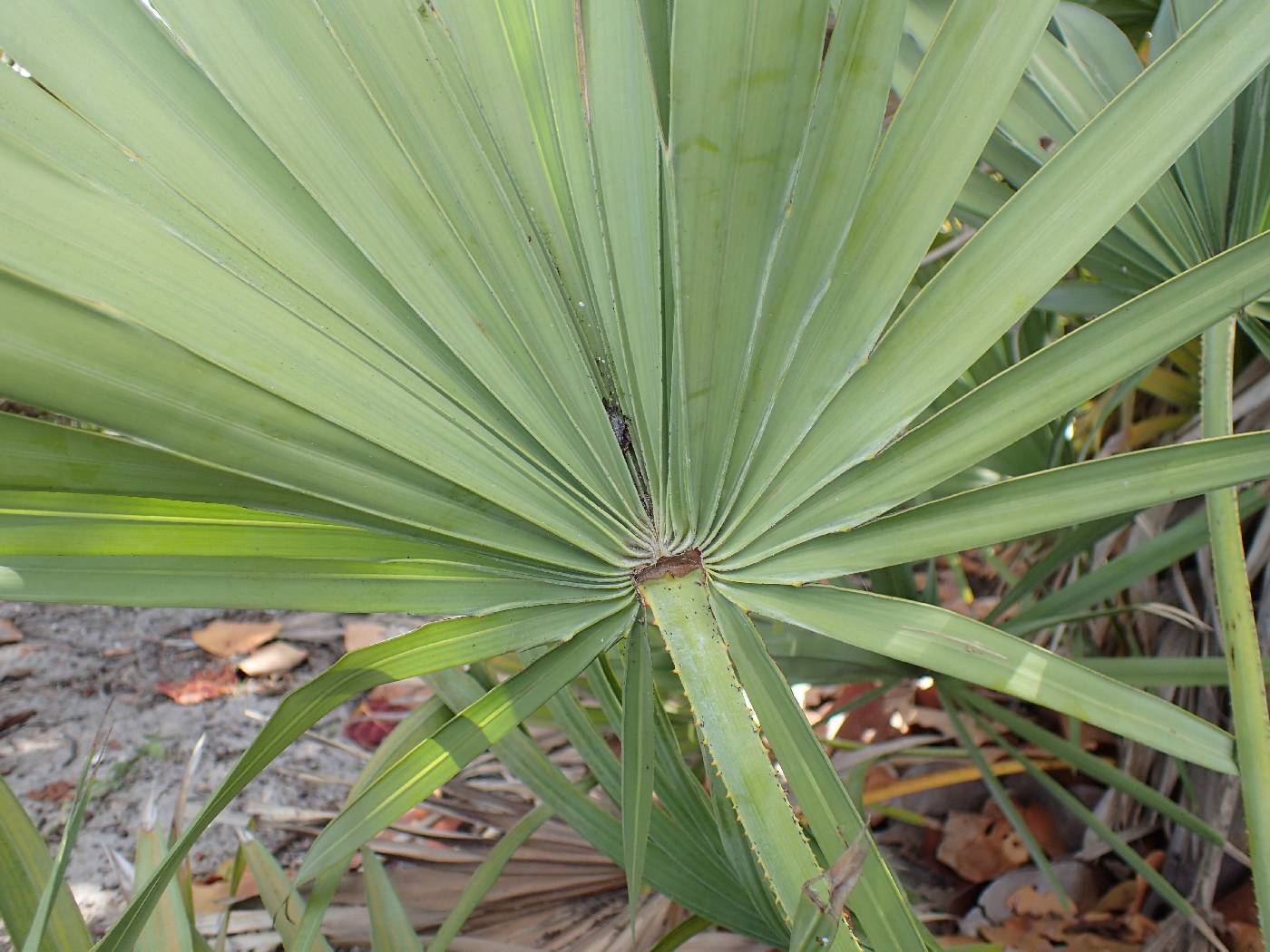Arecaceae
|
Arecaceae |
|
|
Trees or shrubs [lianas], perennial, branched or unbranched, solitary or clustered. Roots adventitious, thick. Stems woody, subterranean or terrestrial, creeping or erect [climbing], slender or massive, sometimes conspicuously enlarged and storing starch and water, smooth or covered with fibrous or prickly remains of leaf bases. Leaves spirally arranged; sheaths tubular, often forming crownshaft, sometimes with ligular appendages; petioles terete, channeled, or ridged, unarmed or bearing prickles or marginal teeth; hastula (flap of tissue from petiole apex at junction with surface of blade) absent or present adaxially, rarely present abaxially. Leaf blade palmate, costapalmate (intermediate between palmate and pinnate), pinnate, or 2-pinnate [undivided]; plication (folding lengthwise into pleats or furrows) ^ - or tent-shaped (reduplicate, splitting along abaxial ridges) or V-shaped (induplicate, splitting along adaxial ridges); segments lanceolate, linear, or cuneate [rhombic], glabrous or variously scaly, unarmed or bearing prickles (proximal segments modified into spines in Phoenix). Inflorescences from solitary [clustered] axillary buds, borne within, below, or above crown of leaves, paniculate, rarely spicate, usually branched to 1--5 orders; prophyll (1st bract on main inflorescence axis) 2-keeled; peduncular bract(s) (empty bract[s] between 1st prophyll and 1st bract subtending branch) present [absent]; flowers bisexual, unisexual with staminate and pistillate on same plants or on different plants, or both bisexual and unisexual on same plant. Flowers solitary or variously clustered along rachillae of inflorescence, radially symmetric; perianth 1--2-seriate; sepals [2--]3[--4], distinct or connate; petals [2--]3[--4], distinct or variously connate; androecium: stamens [3--]6--34[--1000]; filaments distinct or connate or basally adnate to petals; anthers basifixed or dorsifixed, dehiscing latrorsely or introrsely; staminodes in pistillate flowers distinct or variously connate or adnate to pistil or petals; pistils 1 or 3, distinct or partially connate, each bearing 1 ovule and 1 stigma, or 1 pistil bearing 1--3 ovules and 3 stigmas; styles distinct or connate, short; stigmas dry; pistillode in staminate flower present or absent. Fruits drupaceous or berrylike; stigmatic remains basal or apical; exocarp smooth, warty, prickly, or hirsute [corky or scaly]; mesocarp fleshy or dry and fibrous; endocarp papery, leathery, or bony, sometimes with 3 germinat Modern cladistic analyses place the palms as the sister group to the Commelinanae clade (M. W. Chase et al. 1993; J. I. Davis 1995; M. R. Duvall et al. 1993b), with which they share ultraviolet-fluorescent phenolic compounds in their cell walls and Strelitzia-type epicuticular wax morphology (W. Barthlott and D. Frölich 1983; P. J. Harris and R. D. Hartley 1980). Palms are currently treated as the sole representative of the superorder Arecanae, order Arecales (R. M. T. Dahlgren et al. 1985; R. F. Thorne 1992b). Morphologically the family is diverse and complex (see especially P. B. Tomlinson 1990). The majority of palms produce a single indeterminate stem with axillary inflorescences; several noteworthy departures, however, also occur in numbers of vegetative and floral axes, position of inflorescence, and displacement of terminal bud. Stems may be solitary (monopodial) or clustered (sympodial), erect, prostrate, or lianoid. A majority of palms have unbranched vegetative axes, although aerial branching, sometimes dichotomous, is known in a variety of unrelated genera (e.g., Korthalsia Blume, Nannorrhops H. Wendland). Branching may also be nonaxiallary in some genera (J. B. Fisher et al. 1989). Dispersal of seeds is generally by means of animals for fleshy-fruited palms (S. Zona and A. Henderson 1989). Many species of mammals include palm fruits in their diets (S. H. Bullock 1980; R. F. Harlow 1961; W. D. Klimstra and A. L. Dooley 1990; D. S. Maehr 1984; D. S. Maehr and J. R. Brady 1984), but birds also play a significant role. In the Eastern Hemisphere, Cocos Linnaeus and Nypa Steck have achieved a wide distribution as the result of dispersal by water. For the relationship between palms and seed-eating bruchid beetles (Bruchidae: Pachymerinae: Pachmerini), see C. D. Johnson et al. (1995).
PLANT: Trees or shrubs usually with unbranched smooth or spiny stems bearing an apical tuft of leaves. LEAVES: large, petiolate, the blade pinnately or palmately cleft or compound. INFLORESCENCE: large, usually axillary panicles. FLOWERS: small, numerous, perfect or imperfect, the plants monoecious or dioecious; sepals 3; petals 3, larger than the sepals; stamens usually 6; pistil 3(-10)-carpelled, the ovary superior with 1 ovule in each locule. FRUITS: fleshy or dry and fibrous, berries or drupes, with 1 locule fertile. SEEDS: with abundant oily endosperm. NOTES: Ca. 212 genera; 2780 spp.; chiefly of tropical and subtropical regions. Includes Phoenix dactylifera L., the date palm and Cocos nucifera L., the coconut palm. REFERENCES: Mason, Charles T., Jr. 1999. Arecaceae. Ariz.-Nev. Acad. Sci. 32(1). |
|
